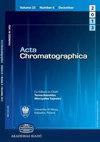高效薄层色谱(HPTLC)同时测定片剂中对乙酰氨基酚、咖啡因、氯苯那敏和苯肾上腺素的方法建立与验证
IF 1.7
4区 化学
Q3 CHEMISTRY, ANALYTICAL
引用次数: 2
摘要
开发并验证了一种快速、选择性和精确的高效薄层色谱法,用于同时分析片剂中的对乙酰氨基酚、咖啡因、苯肾上腺素和氯苯那敏。色谱分析在预涂有硅胶60F254作为固定相的玻璃板上进行。优化的流动相为甲醇:正丁醇:甲苯:乙酸(8:6:4:0.2v/v)。TLC室,共10个 × 20 cm,饱和时间为15 min。发现扑尔敏、苯肾上腺素、咖啡因和扑热息痛的阻滞因子(RF)为0.15 ± 0.02、0.29 ± 0.02、0.50 ± 0.02,0.68 ± 0.02。在212进行检测 nm。根据ICH Q2(R1)指南进行验证研究。校准图的回归数据显示,在300–1500的浓度范围内,R2=0.997具有良好的线性关系 咖啡因的ng带−1,在100–500的浓度范围内,R2=0.996 在200–600的浓度范围内,苯肾上腺素的ng带−1,R2=0.996 氯苯那敏的ng带−1,在400–2400的浓度范围内,R2=0.998 对乙酰氨基酚的ng带−1。验证了该方法的精密度、准确度和回收率。最小可检测量为304.9 ng波段−1,87.88 ng波段−117.18 ng波段−1和143.06 咖啡因、苯肾上腺素、氯苯那敏和扑热息痛的ng带分别为−1,而定量限为923.95 ng波段−1266.32 ng波段−1355.11 ng波段−1和433.53 ng波段−1。该方法以选择性和可重复性的方式成功地应用于两种上市片剂的分析。本文章由计算机程序翻译,如有差异,请以英文原文为准。
High performance thin layer chromatography (HPTLC) method development and validation for the simultaneous determination of paracetamol, caffeine, chlorpheniramine and phenylepherine in tablet formulation
A rapid, selective, and precise high performance thin layer chromatographic method was developed and validated for the simultaneous analysis of paracetamol, caffeine, phenylephrine and chlorpheniramine in tablets. The chromatographic analysis was carried out on glass plates pre-coated with silica gel 60 F254 as a stationary phase. The optimized mobile phase was methanol : n-butanol : toluene : acetic acid (8:6:4:0.2 v/v). TLC chamber of 10 × 20 cm was used with saturation time of 15 min. The retardation factor (RF) for chlorpheniramine, phenylephrine, caffeine and paracetamol was found to be 0.15 ± 0.02, 0.29 ± 0.02, 0.50 ± 0.02, 0.68 ± 0.02 respectively. Detection was carried out at 212 nm. Validation study was done following ICH Q2 (R1) guideline. The regression data for the calibration plots showed good linear relationship with R
2 = 0.997 over the concentration range of 300–1,500 ng band−1 for caffeine, R
2 = 0.996 over the concentration range of 100–500 ng band−1 for phenylephrine, R
2 = 0.996 over the concentration range of 200–600 ng band−1 for chlorpheniramine, R
2 = 0.998 over the concentration range of 400–2,400 ng band−1 for paracetamol. The method was validated for precision, accuracy and recovery. Minimum detectable amounts were found to be 304.9 ng band−1, 87.88 ng band−1, 117.18 ng band−1 and 143.06 ng band−1 for caffeine, phenylephrine, chlorpheniramine, and paracetamol respectively while the limit of quantification was found to be 923.95 ng band−1, 266.32 ng band−1, 355.11 ng band−1, and 433.53 ng band−1 in the same order. The method was successfully applied to analyze two marketed tablets in a selective and reproducible manner.
求助全文
通过发布文献求助,成功后即可免费获取论文全文。
去求助
来源期刊

Acta Chromatographica
化学-分析化学
CiteScore
4.00
自引率
0.00%
发文量
55
审稿时长
2.3 months
期刊介绍:
Acta Chromatographica
Open Access
Acta Chromatographica publishes peer-reviewed scientific articles on every field of chromatography, including theory of chromatography; progress in synthesis and characterization of new stationary phases; chromatography of organic, inorganic and complex compounds; enantioseparation and chromatography of chiral compounds; applications of chromatography in biology, pharmacy, medicine, and food analysis; environmental applications of chromatography; analytical and physico-chemical aspects of sample preparation for chromatography; hyphenated and combined techniques; chemometrics and its applications in separation science.
 求助内容:
求助内容: 应助结果提醒方式:
应助结果提醒方式:


